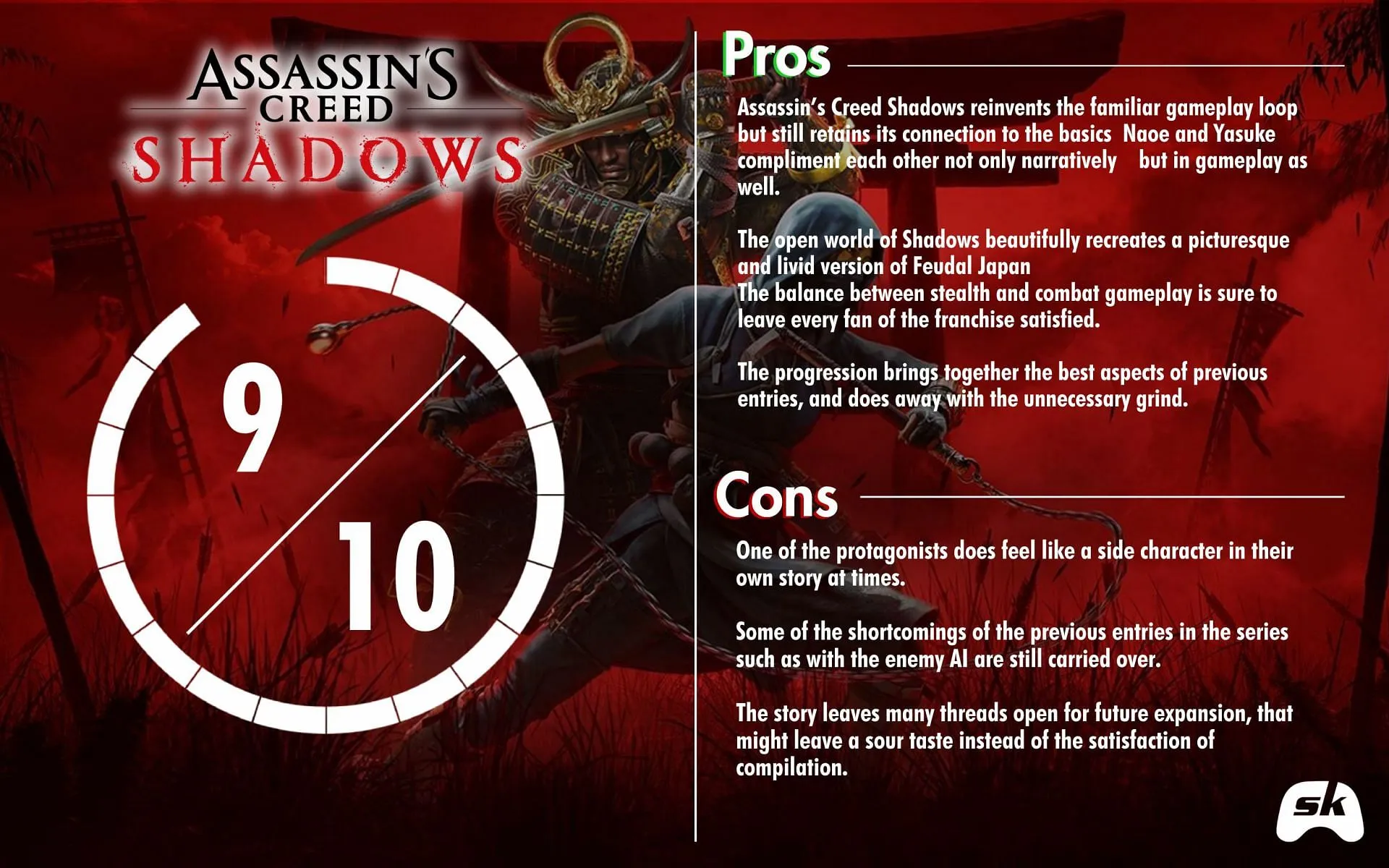Assassin’s Creed Shadows delivers an exhilarating experience from the outset, yet it’s a peaceful moment during a rain-soaked ride along the coastline that truly captivated me. Amidst the tumultuous weather, I discovered a serene beauty that showcases the rich world of Assassin’s Creed Shadows.
This marks my second encounter with Assassin’s Creed Shadows, having previously sampled it at Ubisoft’s studio earlier this year. However, my optimism from those preview sessions shifted to skepticism as I embarked on this review. I diligently searched for flaws, examining the game’s weak points. Despite identifying a few shortcomings here and there, my overall impression of Assassin’s Creed Shadows remains profoundly positive, leaving me eager for its release.
I look forward to returning to the lush landscapes of Feudal Japan, where the gentle breeze carries familiar scents and the promise of adventure awaits.
Premise: Upholding the Franchise’s Legacy
Before delving into Shadows and its unique offerings, it’s essential to appreciate its place within the expansive Assassin’s Creed franchise, which boasts a legacy spanning over 15 years. The reception of Shadows has been mixed among fans; its narrative follows the RPG-path pioneered by Origins, Odyssey, and Valhalla, leaving some feeling distanced while positioning itself for a generational leap forward.
Feudal Japan, long sought after by the community, was once deemed implausible, much like the Ancient Egypt of Origins, but as history often shows, possibilities abound.
This era, rife with warring factions, honor, and stratified social classes, finds its narrative setting between the conclusion of the Muromachi and the initiation of the Azuchi–Momoyama periods. Key historical figure Oda Nobunaga, Japan’s first Great Unifier, is central to the unfolding story.
Various interpretations of Feudal Japan permeate the media landscape, ranging from award-winning shows like Shogun to the critically acclaimed Ghost of Tsushima. While Shadows inevitably invites comparisons, I believe it carves its own distinct niche, relying on subjective preferences rather than direct competition. This brings us to a critical element: the protagonists.
Dual Protagonists: The Complexity of Shadows
Crafted by the same team responsible for Odyssey and Syndicate, Shadows features dual protagonists—Yasuke and Naoe. Unlike previous games, these characters are intricately developed, deeply influencing player choices and gameplay dynamics.
Initially introduced as a slave forced to assist Portuguese priests in spreading Christianity, Yasuke quickly rises to become a formidable Samurai under Nobunaga’s patronage, aiding in the quest for unification through bloodshed.
In contrast, Naoe represents the human cost of Nobunaga’s conquests. The emotional weight of her father’s death due to Yasuke’s mission failure renders her relatable and complex, highlighting her grief and resolve.
The juxtaposition between Yasuke’s stoicism and Naoe’s emotional vulnerability allows for nuanced gameplay experiences, catering to various player preferences. Assassin’s Creed fans remain divided; some cherish the stealth-oriented gameplay of earlier titles, while others embraced the combat-driven heavyweights like Odyssey and Valhalla. Intriguingly, both Yasuke and Naoe are crafted to appeal to both clans, necessitating a deeper understanding of their stories.
Engaging Storyline: A Conflict of Change
Shadows unfolds during a transformative historical period, providing fertile ground for intricate character arcs and the perennial struggle between the Assassin Brotherhood and the Templar Order.
Reflecting on Valhalla, I found it lacking a cohesive narrative thread, which left me feeling dissatisfied. Shadows, however, excels in this regard.
The Shibakufu, led by the enigmatic Onyo, becomes the primary antagonist, comprising twelve masked figures who sway the region’s power dynamics. The plot ignites when Naoe, unable to secure a mysterious box hidden by the Assassins, inadvertently causes her father’s demise.
This setback spurs Naoe into a quest for revenge, creating alliances along the way. Yasuke’s involvement adds additional layers, as his motives unfold gradually, heightening tension and suspense. However, I did notice that at times, Yasuke’s role feels secondary despite being one of the protagonists.
Beyond the central narrative, each protagonist’s individual storyline enriches the game world, adding depth to the immersive setting of Feudal Japan, which arguably stands as one of the most compelling aspects of this title. Nevertheless, I sensed that the conclusion felt abrupt, with unresolved threads hinting at future expansions that could potentially frustrate players seeking closure.
The Open World: Beauty and Danger
Ubisoft’s legacy in open-world design remains unparalleled, and Shadows exemplifies this tradition. The map, although limited to Japan’s Kansai region—home to Kyoto and Osaka—ranks as the second-largest in the series, just behind Odyssey’s expansive landscape. Despite its size, the world remains meticulously detailed.
Distinct Regions
Shadows features nine diverse regions, each marked by its history and culture. For example, Sakai differs vastly from the opulent political backdrop of Kyoto, showcasing the variety within the game’s landscape.
The interconnected regions blend lush forests, tranquil fields, and majestic snow-capped mountains, all enhanced by an innovative seasonal weather system.
Shadows boasts four seasons—Summer, Autumn, Winter, and Spring—each altering not only the scenery but also NPC behaviors. This dynamism enhances strategic gameplay, as environmental changes may affect stealth approaches and combat tactics.
Castles as Strongholds
Beyond standard bandit camps, taking control of castles presents a thrilling challenge. Each stronghold features a significant enemy presence, including the formidable Samurai Daimyo. Successfully navigating these environments yields rich rewards, such as Legendary gear and Mastery Points.
Infiltrating castles can be exhilarating, whether through stealth or all-out combat, allowing players to engage with the environment in multiple ways.
Manage Your Hideout
Shadows revitalizes the hideout concept from earlier entries, enabling players to construct their base in a more interactive way. This feature allows greater agency in shaping players’ experiences, from weapon upgrades to managing scouts.
The game offers two modes—guided and exploration—each altering how objectives are presented and how players interact with the world. Additionally, minor hideouts known as Kakurega can be established across cities, deepening the sense of community building reminiscent of the Brotherhood’s early days.
Engaging Activities and Temples
Within the immersive world, players can discover numerous temples and shrines, as well as partake in activities such as Kuji-Kiri and Horse Archery. Completing these tasks contributes to Knowledge rank progression, allowing players to unlock higher-level skills.
Overall, the open world of Shadows is a vibrant tapestry, merging lively cities and serene temples into a captivating exploration experience.
Visuals: A Generational Advancement
While technical aspects typically do not dominate my reviews, Shadows deserves special mention for its stunning visuals. Surpassing even the remarkable graphical fidelity of titles like Unity and Origins, Shadows sets a new standard.
Ray tracing enhances both lighting and shadow accuracy, integral to stealth gameplay. Combined with motion-captured cutscenes and finely detailed character models, Shadows stands as a visual marvel.
The implementation of an advanced weather system creates realistic interactions within the game world. Although comparisons to Ghost of Tsushima’s wind mechanics are unavoidable, I stand by the belief that Shadows offers an elevated approach.
This improvement can be attributed to Ubisoft’s upgraded Anvil engine—an evolution I hope will persist in future titles, ensuring consistency in visual fidelity.
Gameplay: A Harmonious Balance
Since the introduction of Origins, the Assassin’s Creed franchise has grappled with balancing stealth and combat. Shadows appears to have struck an equilibrium, blending mechanics seamlessly through its protagonists, Naoe and Yasuke.
While Naoe embodies the agile shinobi with superior stealth capabilities, Yasuke stands as a powerhouse in combat, representing the traditional Samurai archetype. This distinction translates into varied gameplay styles, catering to player preferences.
Stealth Mechanics
Stealth remains vital to the franchise, and Shadows introduces innovative mechanics, including a prone feature that enhances stealth strategies considerably. Light and shadow dynamics become integral as Naoe can manipulate her surroundings to escape detection.
However, I noticed some shortcomings with enemy AI, as they often lack appropriate awareness, making stealth a less challenging element compared to past titles. Furthermore, parkour mechanics have been updated with the introduction of a grappling hook, reminiscent of Syndicate, which adds fluidity to traversing environments.
Naoe’s arsenal includes various stealth tools, including shuriken and smoke bombs, enriching the gameplay experience significantly. All things considered, Shadows showcases a much-needed evolution in stealth mechanics.
Combat Experience
While Naoe can hold her ground, shadows firmly establishes Yasuke as the main combatant. His weapon variety includes traditional melee options such as Naginata and Kanabo, as well as ranged choices like the Teppo and Bow.
The focus on quality over quantity translates into combat refinement, enhancing the overall experience. Shadows carries over active abilities from earlier titles, calling them “Posture Attacks,” which are integrated into a dedicated skill tree for weapon mastery.
Though players might find the selection limiting at launch, expansions are likely to introduce new weapons to keep the gameplay engaging.
Progression: A Return to Tradition
Following the inconsistency in progression from the previous titles, Shadows reinstates a traditional level-based system. It encourages balanced growth without imposing punitive grinding for lower-level players.
Mission Structure
The mission-board format returns, allowing players to visualize assignments alongside character connections effectively. This approach streamlines the narrative while maintaining engagement.
Dynamic Target System
(Minor spoiler ahead)
While the Shibakufu serves as the primary antagonist, numerous factions add complexity and diversity to the gameplay experience, enriching narrative dynamics and player interactions.
Skills and Knowledge System
Unlike Valhalla’s extensive skill constellation that felt inconsequential, Shadows offers a thoughtful approach to skills, ensuring each one contributes meaningfully. Each protagonist has six skill trees that encourage personalized play styles.
A unique Knowledge level system controls skill acquisition, motivating players to engage with various in-game activities—showcasing the game’s intricate world rather than rushing through it.
Gear Customization
Prioritizing quality, Shadows simplifies gear management to armor and headgear, streamlining the customization experience without overwhelming players with excessive gear pieces.
This approach feels balanced, offering a sufficient level of customization while benefiting gameplay rather than detracting from it.
Conclusion: The Position of Assassin’s Creed Shadows
As I embarked on writing this review, I found myself at a crossroads: should I compare Shadows to earlier games or view it as a fresh installment as Ubisoft intends? In an era marked by unmet expectations from many titles, it’s crucial to approach Shadows without preconceived biases.
Setting aside my personal attachment to the franchise, I contend that Shadows emerges as a modern ambassador of the iconic Assassin’s Creed series, encapsulating action-adventure stealth within the mesmerizing landscape of Feudal Japan.
The narrative intertwines two distinct protagonists’ journeys without feeling forced, set within an expansive open world full of engaging activities that never overwhelm the player. The progression system offers obstacles that encourage skill mastery while sidestepping the pitfalls of grind-heavy gameplay.
Ultimately, Assassin’s Creed Shadows might signify the culmination of the contentious RPG era, unifying elements of stealth and action while revitalizing the franchise for a new generation of players.
Assassin’s Creed Shadows

- Platforms: PC, PlayStation 5, Xbox Series X|S
- Reviewed on: PC (Code provided by Ubisoft)
- Developer: Ubisoft Quebec
- Publisher: Ubisoft
- Release Date: March 20, 2025


